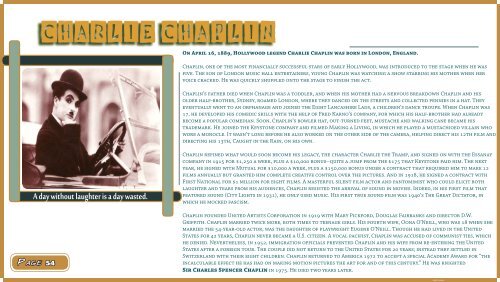You also want an ePaper? Increase the reach of your titles
YUMPU automatically turns print PDFs into web optimized ePapers that Google loves.
Charlie Chaplin<br />
On April 16, 1889, Hollywood legend Charlie Chaplin was born in London, England.<br />
Chaplin, one of the most financially successful stars of early Hollywood, was introduced to the stage when he was<br />
five. The son of London music hall entertainers, young Chaplin was watching a show starring his mother when her<br />
voice cracked. He was quickly shuffled onto the stage to finish the act.<br />
Chaplin’s father died when Chaplin was a toddler, and when his mother had a nervous breakdown Chaplin and his<br />
older half-brother, Sydney, roamed London, where they danced on the streets and collected pennies in a hat. They<br />
eventually went to an orphanage and joined the Eight Lancashire Lads, a children’s dance troupe. When Chaplin was<br />
17, he developed his comedic skills with the help of Fred Karno’s company, for which his half-brother had already<br />
become a popular comedian. Soon, Chaplin’s bowler hat, out-turned feet, mustache and walking cane became his<br />
trademark. He joined the Keystone company and filmed Making a Living, in which he played a mustachioed villain who<br />
wore a monocle. It wasn’t long before he also worked on the other side of the camera, helping direct his 12th film and<br />
directing his 13th, Caught in the Rain, on his own.<br />
A day without laughter is a day wasted.<br />
Page 54<br />
Chaplin refined what would soon become his legacy, the character Charlie the Tramp, and signed on with the Essanay<br />
company in 1915 for $1,250 a week, plus a $10,000 bonus--quite a jump from the $175 that Keystone paid him. The next<br />
year, he signed with Mutual for $10,000 a week, plus a $150,000 bonus under a contract that required him to make 12<br />
films annually but granted him complete creative control over the pictures. And in 1918, he signed a contract with<br />
First National for $1 million for eight films. A masterful silent film actor and pantomimist who could elicit both<br />
laughter and tears from his audiences, Chaplin resisted the arrival of sound in movies. Indeed, in his first film that<br />
featured sound (City Lights in 1931), he only used music. His first true sound film was 1940’s The Great Dictator, in<br />
which he mocked fascism.<br />
Chaplin founded United Artists Corporation in 1919 with Mary Pickford, Douglas Fairbanks and director D.W.<br />
Griffith. Chaplin married twice more, both times to teenage girls. His fourth wife, Oona O’Neill, who was 18 when she<br />
married the 54-year-old actor, was the daughter of playwright Eugene O’Neill. Though he had lived in the United<br />
States for 42 years, Chaplin never became a U.S. citizen. A vocal pacifist, Chaplin was accused of communist ties, which<br />
he denied. Nevertheless, in 1952, immigration officials prevented Chaplin and his wife from re-entering the United<br />
States after a foreign tour. The couple did not return to the United States for 20 years; instead they settled in<br />
Switzerland with their eight children. Chaplin returned to America 1972 to accept a special Academy Award for “the<br />
incalculable effect he has had on making motion pictures the art for and of this century.” He was knighted<br />
Sir Charles Spencer Chaplin in 1975. He died two years later.<br />
Abhi Sharma


